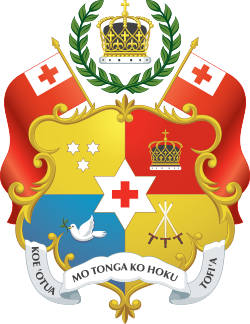Coat of arms of Tonga
From Wikipedia, the free encyclopedia
The coat of arms or national seal of Tonga (ko e Sila ʻo Tonga) was designed in 1875 with the creation of the constitution.
| Coat of arms of Tonga Sila ʻo Tonga | |
|---|---|
 | |
| Armiger | Tupou VI, King of Tonga |
| Adopted | 4 November 1875 |
| Crest | the Royal Crown of Tonga within an olive wreath. |
| Shield | Quarterly; first, Or, three mullets of six points argent; second, Gules, the Royal Crown of Tonga proper; third, Azure a dove volant argent holding an olive branch vert; fourth Or, three swords in fret argent; overall, a mullet of six points argent charged with a cross couped gules. |
| Supporters | Flags of Tonga |
| Motto | Ko e ʻOtua mo Tonga ko hoku Tofiʻa "God and Tonga are my inheritance" |
Description
The routinely used version of the coat of arms is split into four quarter sections. The three islands of Tonga are represented by three stars in the upper left quadrant. The monarchy of the country is shown by a crown in the upper right. The general idea of peace is shown by a white dove and olive branch in the bottom left. Lastly, the bottom right has three swords that showcase the three monastical family lines that have ruled the nation. In addition to this crest, two flags, a laurel wreath, and another crown are featured behind, with the nation's motto Ko e 'otua mo Tonga ko hoku tofi'a (God and Tonga are my inheritance) written below.[1]
Royal Standard
The Royal Standard of Tonga is the monarch's personal flag and is an armorial banner of the Royal Arms of Tonga.
- The Royal Standard of Tonga
See also
References
External links
Wikiwand - on
Seamless Wikipedia browsing. On steroids.

